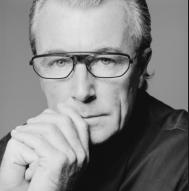












The magazine of the art-form of the photo-essay
“A free, really high quality photo-essay magazine. Fabulous!”
Stephen Fry. British actor, writer and film & documentary maker


Oct 2013 back issue


Terry O’ Neill has been photographing the rich and famous for 50 years. His latest book Terry O’Neill is a look back at
his career.
Over the years Terry’s work has captured the iconic, candid, and unguarded moments of the famous and the notorious
- from Ava Gardner to Amy Winehouse, from Churchill to Nelson Mandela, from the earliest photographs of young
emerging bands such as the Beatles and the Rolling Stones to her Majesty the Queen at Buckingham Palace.
Terry O’Neill, with a foreword by GQ magazine Editor, Dylan Jones, is available in hardback

Terry O'Neill took this black and white photgraph of actor
Michael Caine on set of Get Carter, 1971.

Amy Winehouse, London 2008.

Frank Sinatra with his stand-in and bodyguards arriving on location, Miami Beach, 1968.

Mick Jagger Fur, London 1964.

Jean Shrimpton Terence Stamp, London 1963.

David Bowie working on the Album cover for Diamond Dogs, London
1975.

Audrey Hepburn during filming for Two for the Road 1967.

Brigitte Bardot, Spain 1971.

Raquel Welch in a publicity shot for one million years BC, 1968.

Sean Connery on the Moon.

Life Force magazine’s Editor spoke to Terry O’Neill
about photography, friends, football and online magazines
Life Force magazine spoke to Terry O’Neill about photography, friends, football and online
magazines. To see what he had to say, scroll down.
Damian: When did you decide portraiture was going to be one of your
passions?
Terry: Well I just fell into it actually. When I first started I used a photographer called
W Eugene Smith as a guide. I really liked his work, he was a top photojournalist,
and I tried to copy it. But then one thing led to another and I got a job on a
newspaper and then I started doing a lot of personalities and then I became known
for doing portraiture. It wasn't anything I set out to do. I always thought I was going
to have to get a proper job one day after all this 60s stuff was over. We used to sit
with the Beatles and The Stones and we used to talk about what jobs we were going
to get when all this was over.
Damian: Well of course, you're all doing the jobs that everyone wants!
Terry: Yeah
Damian: We're all conditioned nowadays at school to seek out a proper job. And to be 'proper' it has to be
nine to five.
Terry: Well it was also like that in those days too, but when we got given a chance to do something we just grabbed it
with open hands, but we still all thought we'd have to get a proper job one day.
Damian: Do you still work with The Stones?
Terry: No not really, not now. I'm semi-retired now and I just do jobs that take my fancy. I've always wanted to
photograph Pele and I went across and photographed him for his management team because he's going to be the face
of the next World Cup, next year.
Damian: What was Pele like?
Terry: Oh a fabulous man, a really great man. I'm really pleased I did it.
Damian: Are you a big football fan yourself?
Terry: Oh yeah, enormous.
Damian: Do you get to many games?
Terry: No, no. I watch it on TV. There's enough of it on TV I can tell you.
Damian: One of my favourites, of your portraits, is one of a young Michael Caine. I'm sure you've
photographed him many times but when was the first time you photographed Michael?
Terry: On a film called Get Carter which was made up in Newcastle. That was when I first met him. He was a great bloke
and we just hit it off. We've stayed friends all this time.
Damian: When did you last photograph him?
Terry: About five years ago. I mean, I have lunch with him, I'm having lunch with him next week but we're just friends
now.
Damian: When you started to specialise in taking portraits, did you find that you had a particular technique or
formula?
Terry: Well no. I was one of the first photographers in Fleet Street to use 35mm and it was a candid, intimate kind of
photography. So that was just my style. It was brought about by the camera more than anything else. For instance,
when I went to Hollywood all the photographers there, all used the old plate cameras and all that and people loved
working with me because it was quick and I could do like three rolls of film by the time they'd taken one plate, you know,
one shot. So I was really popular in Hollywood. And that's what helped my whole career.
Damian: So you allowed people to be spontaneous and just be themselves?
Terry: Yes.
Damian: Did you find that part of creating such successful and iconic portraits was just having fun with
people?
Terry: Well yes and if I didn't know anything about them, I always read up about them and I always made them feel, you
know, dignified. I think that's an important part of photography. I mean the paparazzi just want to haul people down.
It's all wrong.
Damian: It's really obscene isn't it.
Terry: Yes it's really obscene. They should be arrested. I don't know why every country doesn't bring a law in and stop
it. It's really sick and unhealthy.
Damian: We publish a lot of the work of one of your friends, David James.
Terry: Oh yes. He's a very good photographer.
Damian: He does a lot of film stills as you know and he always says that the only aspect of photography that
he sees as completely separate and different is the realm of the paparazzi and that it was about stealing
something rather than creating something.
Terry: Yes and they're not even photographers. You could train a monkey to do what they do.
Damian: Are there any aspects of photography that you have on a list to do that you would like to?
Terry: Um no, not really. I mean, I don't like cameras. I hate cameras. I'm a hired gun really. I only take pictures when
I'm paid. I'm not into the ins and outs. I don't take loads of family portraits. I don't take a camera on holiday. That's
not my nature. When I take a picture I have to do everything perfectly and I don't want to do that on holiday! [laughs]
Damian: You've worked with many, many people over the years, some of whom have sadly left us.
Terry: Yes
Damian: What was it like to work with Amy Winehouse?
Terry: Oh it was fabulous. I'd always wanted to photograph her and I was working with Nelson Mandela at the time for
his 90th birthday and there was a concert for him in Hyde Park, so I took him over and I just managed to get this one
shot of her, that I got her to sign for him, for his 90th birthday. And it was a great pleasure. I've worked with great
people: Sinatra, Dean Martin all the greats. I mean, I've had a fabulous life so I can't complain about anything. But
there's nobody around that I want to shoot anymore. That's the problem.
Damian: Do you think that stars have changed over the years?
Terry: Oh yeah, the whole thing (business) has changed. And all the stars' PRs want to have control of the pictures
and say to me 'you can only use this picture here and that picture there' and I just won't live with that. It's not how I
ever used to work. I mean, when I used to work with Sinatra I used to show him all the pictures I took and it was all
fine. There wasn't ever a problem with any of them.
Damian: Just two artists working together.
Terry: Yes, exactly. Well put.
Damian: Obviously there are lots of print magazines, but how do you feel about online only magazines?
Terry: Well I like anything that comes out that's new. Everything should be given a chance.
Damian: Thank you Terry for giving us a chance! Thank you so much for talking to us Terry.
Terry: OK, I enjoyed it. Thank you.
September 2013











